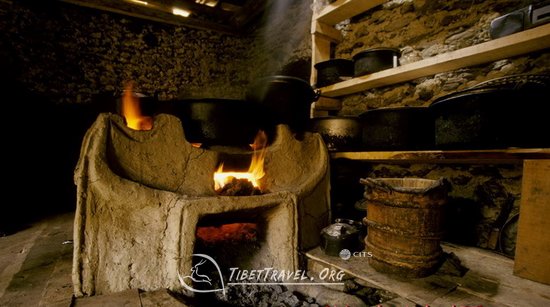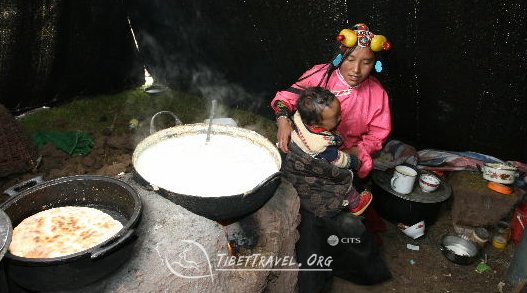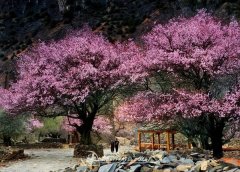
Unique Tibetan Stove
If you pay a visit to a local Tibetan family when you travel in Tibet, you can ask admission from the host to visit their kitchen when you may see a unique Tibetan stove. In fact, you can also see Tibetan stoves in a family hostel, such as at Rongbuk Tent Guesthouses. Traditional Tibetan stoves are made from mud and bricks.

A Tibetan stove, laid up by baked adobes, has fire inlet, ash outlet, ash pit and several stove mouths. On the left in front of the stove, there is a small built-in cabinet.
The Low, narrow and long Tibetan fire stove extends from the ash pit along the wall. In the past, poor family usually put the sleeping place nearby the fire stove and warmed themselves with the remaining heat of caw dung ash in the night. There are three stove gods: the god of water, the god of fire and the god of food. If adding the god of wealth, there will be four family gods. The relationship between the stove god and people is intimate, but if the stove god was desecrated or offended, he will bring down disasters.
Therefore Tibetans are forbidden to roast meat directly on flame: to stride over the stove pit; to urinate on the stove pit, to burn bones and skins on fire; to spit the saliva toward the stove. Even for the temporary three stones stove, herdsmen, before leaving, must add into some yak dung for the last time and throw some tsampa in fire or put some offering food on the three stones; by this way people express their thanks for gods.
In daily life, the god of stove can also give people some omens, for example, much smoke or dark red flame is bad omen; bright fire is good omen; if the stove fire sends out the sound like “woo-woo”, it indicates that the guest will present; if the fire sends out excessive voice like “pee-pee, pa-pa”, it shows the spirits or ghosts have entered the house and so on.

Before the ancient time of Tubo king Nyatri dynasty, Tibetan area had already entered in to smelting industry and also had professional ironsmiths.
In the period of the seventh Tubo king dynasty, minister Luo-nang murdered the king, put the corpse into the copper coffin, and then threw it into river. In the period of the ninth king Pu-de-gung-rgyal, Tibetan areas had already had the crafts of smelting metals. In fact, the Yumbulhakang Palace, constructed in the period of the first Tibetan king Nyatri, had already proved the arrival of Tibetan smelting time.
Traditional Tibetan stoves are becoming more difficult to find as more people are choosing to use stoves made from metal. Mud-brick stoves are not difficult to make. They generally take less than a day to build. Besides making minor repairs, the stoves should last for 5 to 7 years before having to be rebuilt. Since most of Tibet is treeless, especially the interior of Tibet, dried yak dung is the only fuel that is used. Collecting yak dung is a very important chore.
Stoves are kept burning nearly all day. Water, along with milk tea or butter tea, are always on the stove. All meals are cooked on these stoves. Winters are extremely cold in most of Tibet so the stoves serve as the only means of heating the tent. Traditional mud-brick stoves are not portable. So when a nomad family prepares to move to a new pasture, the stove is left behind. Nomads usually rotate between 2 and 4 pastures each year and each pasture will have a mud-brick stove. During the morning and evenings families will gather around the stove to talk about the days coming or passing events.

With exceptional passion and outstanding leadership, Mrs. Catherine has dedicated herself to Tibet inbound tourism and China tour for 15 years. As one of the handful females who see great potential of Chinese inbound tourism, Catherine has made great contribution to promoting Tibet tourism and enhancing the employment of Tibetans and prosperity of local Tibetan community.
Over the years, she travelled overseas with Tibet Tourism Bureau many times to promote Tibet tourism. Currently, Catherine works as the marketing director of Tibet Vista, an opinion leader behind the whole team of Tibet Vista.
Related Articles & Posts

Latest Tibet Travel News

Tibet Vista: A Social Responsible Tour Organizer
Aug 14,2023

Tibetan Monks Debate in Drepung Monastery
Jun 10,2023

Tips for Traveling to Tibet in Spring
Feb 17,2022

Snow Will Hit Qinghai-Tibet Plateau
Feb 17,2022


.jpg)




0 Comment ON "Unique Tibetan Stove"